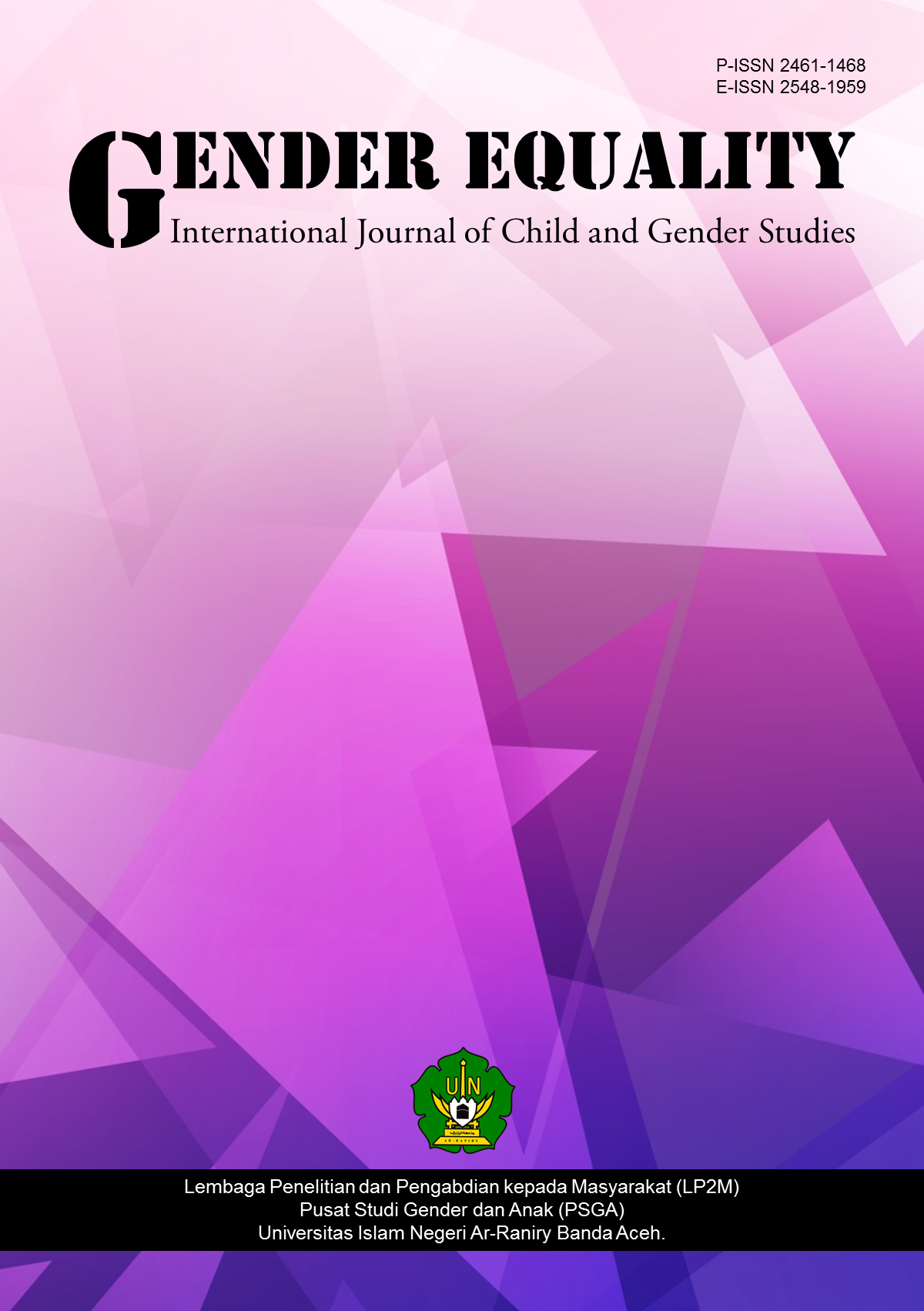Analysis of gender roles in agro-industrial workers' families
DOI:
https://doi.org/10.22373/equality.v8i2.14710Keywords:
Gender Roles, Patrilineal, Social ConstructionAbstract
This study aimed to analyze the role division of husband and wife in dual earner families based on gender. Basically, gender roles can be defined as the social relationship between husband and wife and the social construction resulted from that relationship. The consequence is the roles division based on gender may vary between communities, but it can be analyzed by its types (patrilineal, matrilineal, and egalitarian). This research was conducted purposively in Seputih Mataram Sub-district of Central Lampung Regency of Lampung Province by survey method. The research samples were 85 dual earner families, in which husband and wife of the family work as laborers in agricultural or agro-industry companies. The results of this research indicated that the family of agro-industry workers belonged to the patrilineal type family. Patrilineality in the family could be based on the division of family gender roles. Gender roles in the domestic sphere was charged to wives and in the social sphere was charged to husbands. This happens because of the social construction process that has been going on from one generation to another. It could be proven, for example, by meeting invitations on social activities from the village office are often addressed to husbands. In the domestic area, the division of gender roles is based on the division of tasks based on gender appropriateness, for example the task of cooking is charged to the wife and the task of repairing the house is charged to the husband.References
References
Abercrombie, N., Hill, S., & Turner, B. S. (2006). The penguin dictionary of sociology (5th ed.). London: Penguin Books.
Black, C. F. (2016). Global Gender Gap Report. Encyclopedia of family studies, 1-2, 10.1002/9781119085621.wbefs350. Retrieved July 14, 2022 from http://doi:10.1002/9781119085621.wbefs350.
Blair, S. L., & Lichter, D. T. (1991). Measuring the division of household labor. Journal of Family Issues, 12(1), 91–113. Retrieved July 15, 2022 from http://doi:10.1177/019251391012001007
Blood, R. O., & Wolfe, D. M. (1960). Husbands and wives: The dynamics of married living. Glencoe, IL: Free Press.
Bruce, S., & Yearley, S. (2006). The Sage dictionary of sociology. London: Sage Publications Ltd.
Burns, A., & Homel, R. (1989). Gender division of tasks by parents and their children. Psychology of Women Quarterly, 13(1), 113–125. Retrieved July 15, 2022 from http://doi:10.1111/j.1471-6402.1989.tb00989.x
Rollins, B. C., & Bahr, S. J. (1976). A theory of power relationships in marriage. Journal of Marriage and Family, 38(4), 619–627. Retrieved July 16, 2022 from http://doi:10.2307/350682
Chafetz, J. S (Eds.). (2006). Handbook of the sociology of gender. Berlin: Springer Science & Business Media.
FAO (Food and Agriculture Organization). (2011). The state of food and agriculture 2010–2011: Women in agriculture: Closing the gender gap for development. Roma: FAO.
Greenstein, T. N. (1996). Gender ideology and perceptions of the fairness of the division of household labor: Effects on marital quality. Social Forces, 74(3), 1029-1042. Retrieved July 01, 2022 from https://doi.org/10.1093/sf/74.3.1029
Huber, J., dan Spitze, G. (1983). Sex stratification: Children, housework, and jobs. New York: Academic Press.
Husuna, F., Sondakh, S. J., & Wasak, M. P. (2020). Peran gender pada peningkatan kesejahteraan keluarga nelayan di desa bulawan induk kecamatan kotabunan kabupaten bolaang mongondow timur. Akulturasi: Jurnal Ilmiah Agrobisnis Perikanan, 7(2), 1343-1354. Retrieved July 01, 2022 from https://doi.org/10.35800/akulturasi.7.2.2019.28147
Krejcie, R. V., & Morgan, D. W. (1970). Determining sample size for research activities. Educational and Psychological Measurement, 30(3), 607-610. Retrieved July 02, 2022 from https://doi.org/10.1177%2F001316447003000308
Kuo, P. X., Volling, B. L., & González, R. (2018). Gender role beliefs, work-family conflict, and father involvement after the birth of a second child. Psychol: Men Masculinity 19, 243–256. Retrieved July 03, 2022 from http://doi.org/10.1037/men0000101
Lindsey, L. L. (2016). Gender roles: A sociological perspective (6th ed.). USA: Routledge.
Manembu, A. E. (2017). Peranan perempuan dalam pembangunan masyarakat desa: Suatu studi di desa Maumbi kecamatan Kalawat kabupaten Minahasa Utara. Jurnal Politico, 7(1). Retrieved July 10, 2022 from https://ejournal.unsrat.ac.id/index.php/politico/article/view/16329
Moser, C.O. (1993). Gender planning and development: Theory, practice, and training. London: Routledge
Nuqul, F. L. (2010). Pertimbangan penentuan pengendali keuangan keluarga: Sebuah analisa nilai peran gender dalam interaksi pasangan suami istri. Working Paper. UIN Maliki Malang, Malang. Retrieved July 11, 2022 from http://repository.uin-malang.ac.id/337/1/Keadilan%20dalam%20rumah%20tangga.pdf
Poole, K. T., & Zeigler, L. H. (1985). Women, public opinion, and politics. New York: Longman.
Puspitawati, H., & Siswati, M. K. (2017). Peran gender, pengambilan keputusan, dan kesejahteraan keluarga dual earner. Jurnal Ilmu Keluarga & Konsumen, 10(3), 169-180. Retrieved July 15, 2022 from http://dx.doi.org/10.24156/jikk.2017.10.3.169
Sastrawati, N. (2018). Laki-Laki dan perempuan identitas berbedah analisis gender dan politik perspektif post-feminisme. Makassar: Alauddin Press.
Stoet, G., O’Connor, D. B., Conner, M., Laws, K. R. (2013). Are women better than men at multi-tasking? BMC Psychology, 1(1), 18. Retrieved July 12, 2022 from http://doi.org/10.1186/2050-7283-1-18
Wirls, D. (1986). Reinterpreting the gender gap. Public Opinion Quarterly. Oxford University Press.
Downloads
Published
Issue
Section
License
GENDER EQUALITY: International Journal of Child and Gender Studies allows the author(s) to hold the copyright and to retain the publishing rights without restrictions. Authors who publish with this journal agree to the following terms:
- Authors retain copyright and grant the journal right of first publication with the work simultaneously licensed under a Creative Commons Attribution License that allows others to share the work with an acknowledgment of the work's authorship and initial publication in this journal.
- Authors are able to enter into separate, additional contractual arrangements for the non-exclusive distribution of the journal's published version of the work (e.g., post it to an institutional repository or publish it in a book), with an acknowledgment of its initial publication in this journal.
- Authors are permitted and encouraged to post their work online (e.g., in institutional repositories or on their website) prior to and during the submission process, as it can lead to productive exchanges, as well as earlier and greater citation of published work.



